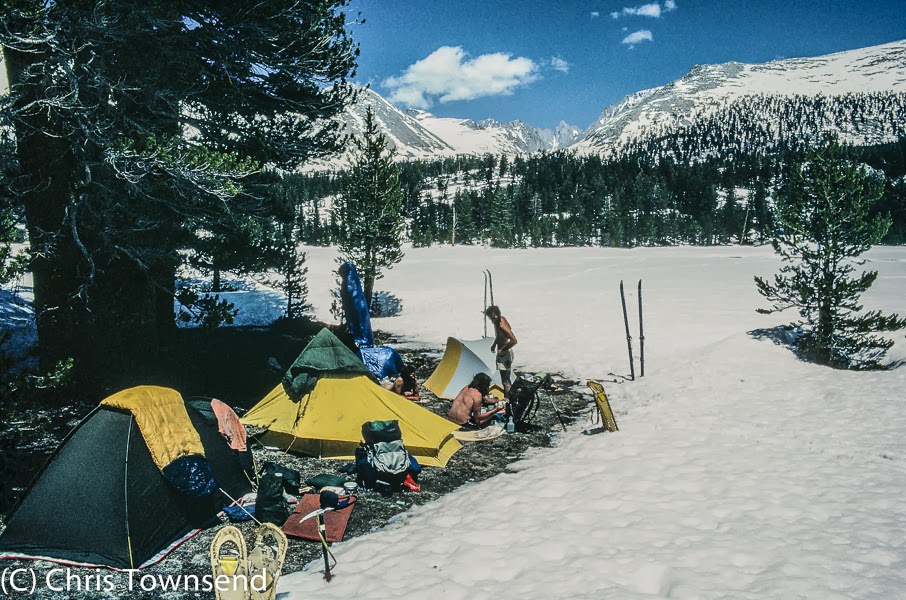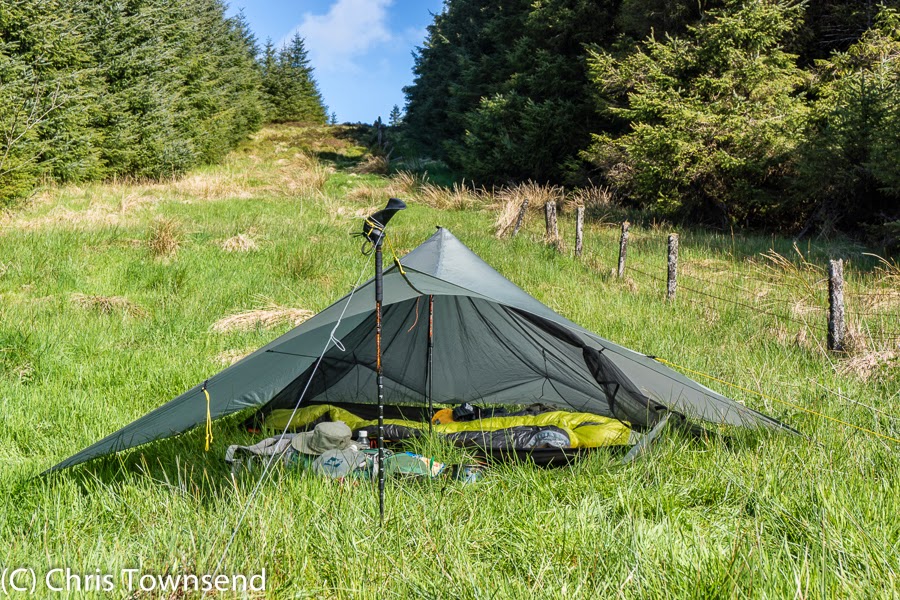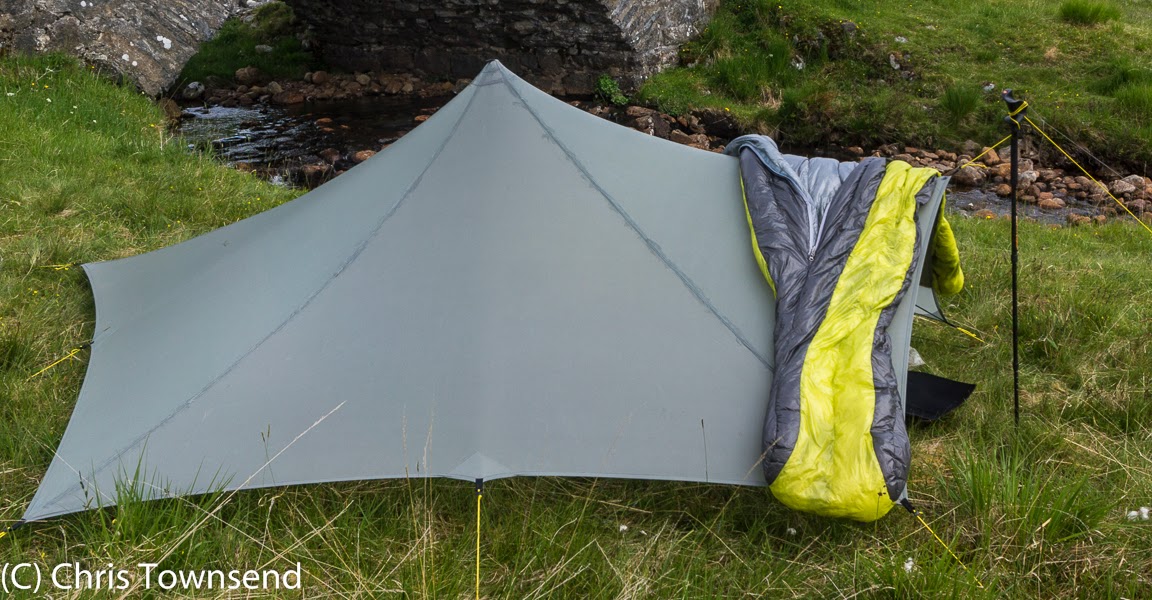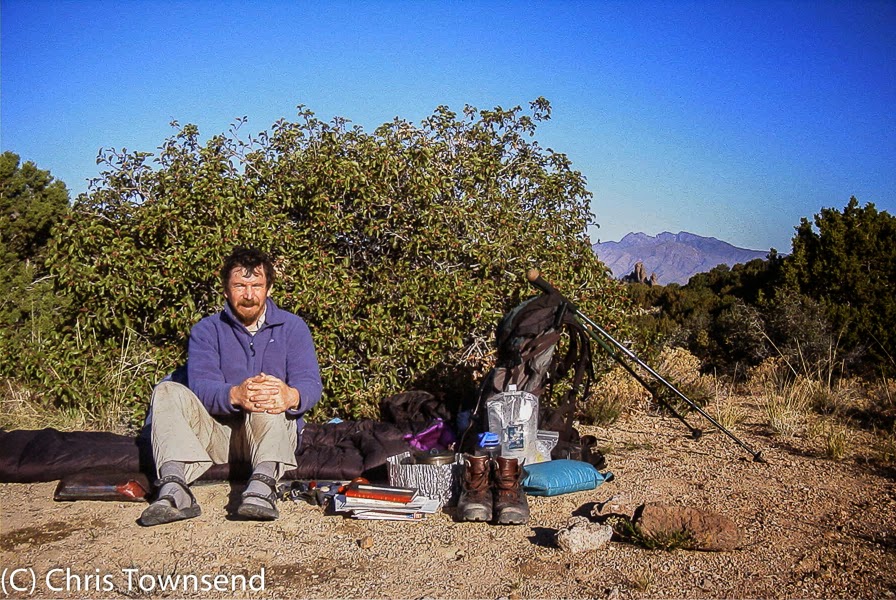 |
| High Sierra camp, Pacific Crest Trail, 1982. My gear bottom left - Wintergear Eyrie Gore-Tex tent, Mountain Equipment Lightline sleeping bag, Therm-A-Rest, Berghaus Cyclops Scorpion pack, Sherpa Sno-Claw snowshoes, Simond Couguar ice axe |
Back in 1999 The Great
Outdoors magazine celebrated it's 21st birthday. For the anniversary issue I
wrote a feature about changes in gear during those years. I came across this
piece recently and, with some updates to take account of another 15 years, here
it is.
Aah,
the good old days! Gear was gear then, none of this soft fluffy stuff. And it
was lighter, and tougher. So goes the ageing walker, sitting in the corner of
the bar smelling slightly of dead sheep and mildewed cotton. But what gear were
walkers using in 1978? And was it as
good as the stuff we use now? A quick flip through the pages of the first issue
of The Great Outdoors reveals advertisements for leather boots with stitched
soles, non-breathable cagoules (lots of those), fibre-pile jackets, external
frame packs, ridge tents, tartan wool shirts and cotton windproofs. There are
ads for Gore-Tex and internal frame packs but fleece, lightweight boots, trail shoes, dome
and tunnel tents, trekking poles, GPS and much more are strangely absent. I'm
surprised though at how many of the brand names are familiar - Vango, Mountain
Equipment, Rohan, Karrimor, Berghaus, Field & Trek, Primus, Optimus,
Camping Gaz, Nikwax, Gore-Tex, Zamberlan, Sprayway - but who now remembers Pointfive,
Boylans, Daimor, Bukta, Camp Trails, Hawkins, Munari, Ultimate?
Gear
was a major feature of the first issue of The Great Outdoors with seven pages
devoted to a review of the 1977 Camping Trades Association Exhibition (CTA is
now the Outdoors Industry Association), a page of test reports (a waterproof
cagoule from Clarks (!) and a polyester filled proofed cotton jacket from
Tenson), two pages of thoughts on lightweight camping by Robin Adshead (showing
the lightweight approach was in The Great Outdoors from the start), another two
pages on choosing backpacking gear at the age of fifty by Andrew Harper and a
Meet the Retailer page on The Great Outdoors (of course!), in Yeadon. That's 13
pages in all, a significant chunk of a magazine with just 32 pages of
editorial.
Here
I've taken a dash through the past; seeking out those items that have lasted
and looking at the changes that have taken place.
Boots
What
we put on our feet has changed amazingly. In 1978 the "lightweight
revolution", as it was called, was still a few years away and boots were
generally fairly stiff and heavy and always made from leather. I walked from Land's End to John O'Groats in the spring of 1978 wearing
5 lb leather boots with metal shanks in the soles, something I shudder at now.
The first signs of change came in 1980 with the launch of Karrimor's K-SBs (then
made by Asolo) with fabric/suede uppers and a lightweight flexible synthetic
midsole instead of a stiff leather one. TGO editor Roger Smith wrote in his
review of the 1980 COLA Show that "1981 could be the year when the
lightweight walking boot really makes the breakthrough". He was right and this was reinforced the next
year, 1982, with the launch of the first Brasher Boot and the Scarpa Bionic
range. In that year I became committed to the new footwear after starting my
2,600 mile Pacific Crest Trail walk in 5 lb stiff leather monsters and
finishing in 1.5 lb fabric Asolo approach shoes, the forerunners of today's
trail shoes. Then as now some people felt lightweight footwear was unsuitable
for serious use. In a feature in the February 1993 TGO I wrote "after 1200
miles, with a 60-70 lb pack, I beg to differ". After many, many more miles
with many more loads I still do.
 |
| On the Continental Dvide Trail, 1985. New Balance shoes, Karrimor Condor pack, Rohan clothing, Camera Care Systems camera cases |
Although
improvements continue modern walking boots and shoes are still based on the
designs launched in the early 1980s. The only really new development in the
1990s has been sports sandals, which first appeared in Britain at the
1992 COLA Show and which were first reviewed, very positively, in the September
1993 issue by Cameron McNeish.
However
the 1990s did see an important breakthrough in the boot fitting system
developed by Phil Oren and the use of Superfeet and similar supportive footbeds.
Clothing
 |
| Rohan clothing, Karrimor Condor pack. Continental Divide Trail, 1985 |
If
there is one product that symbolises the difference between 1978 and now it is Gore-Tex.
Waterproofs then were made from non-breathable neoprene or polyurethane coated
nylon. After a day wearing one of these the inside would be running with
condensation. When The Great Outdoors was brand new so was Gore-Tex. In the
first issue Robin Adshead (a leading backpacking writer at the time and author
of Backpacking In Britain, which I
still have) reported on the 1977 COLA Show at which Gore-Tex was launched with
garments from Berghaus and Mountain Equipment. Robin wrote that Gore-Tex
"works well on some people in some weather conditions " (with which many
would still agree) and said of the Mountain Equipment Cascade jacket that it
was "not cheap at £38.50 but if Gore-Tex works, it is well worth the
money". By the June issue he was "totally satisfied that Gore-Tex has
great advantages over less porous waterproof materials". I was convinced
too, having worn a Berghaus Mistral Gore-Tex jacket on my Land's
End to John O'Groats walk and been amazed at how dry I stayed
inside it.
Gore-Tex
didn't sweep non-breathables away immediately though. There were durability
problems with first generation Gore-Tex and it was expensive (second generation
was much longer lasting but less breathable and no less expensive). Slowly
though the idea that wearing waterproofs didn't have to mean soaking in your
own sweat became accepted. Competition is always a sign of success and in 1983
the first alternative to Gore-Tex, Entrant, was launched. This was soon
followed by others, including Sympatex (called Syntatex in TGO!) in 1986 and
Paramo in 1989, and by the end of the decade waterproof/breathable fabrics were
the norm.
The
other great change was the rise of fleece, a name unheard of in 1978 other than
on the backs of sheep, which is ironic in that fleece just about saw the demise
of wool shirts and sweaters for most walkers. The change began in 1982 with the
launch of Mountain Equipment's Thermofleece, followed soon afterwards by
Ultimate Equipment's Polapelt. Ultrafleece, still in my opinion one of the best
fleece fabrics, appeared in 1984 as did Patagonia's
Bunting, which turned into Synchilla a year later. (To be accurate Patagonia
had started the fleece revolution some years earlier in the USA but hadn't
been available here before). Then 1986 saw the first Malden Mills Polarplus
(now Polartec) garments from Berghaus and The North Face and the place of
fleece in outdoor wardrobes was assured.
Before
fleece there was fibre-pile, a somewhat shaggy, scruffy fabric, though with a
better warmth to weight ratio, and after fleece there is still fibre-pile.
Indeed the latest fluffy fleeces look more like pile, as it became shortened
to, than previous fleece fabrics. Some people never abandoned pile however and
paralleling the rise of fleece was the rise of Buffalo with its Pertex/pile garments which
were first launched in 1986 and which is still going. The man behind Buffalo, Hamish Hamilton,
was also the discoverer of the properties of Pertex (and before that the
designer of the original cotton Force Ten tents for Vango).
 |
| Chris Ainsworth on a ski tour in the Alps, 1983. Rohan Super Strider breeches and Rohan shirt. This photo was used in a Rohan catalogue. |
As
well as wool shirts and sweaters and clammy non-breathable waterproofs the
walker of the 1970s wore thick baggy tweed or corduroy breeches or trousers.
Then along came Paul and Sarah Howcroft and a company called Rohan, just
starting out when TGO was launched. Firstly Rohan replaced itchy, heavy wool
legwear with stretchy brushed nylon Super Striders, at the time the best cold
weather legwear available and the first softshell garments (though the name
wasn't used back then). Then for summer came lightweight polycotton trousers
and breeches, derided by many (including some who were to make their own
versions a few years later) as far too light and flimsy for serious use. They
were wrong. My first ever gear review, in the April '79 The Great Outdoors, was
of Rohan Summer Striders. I concluded that these polycotton breeches were ideal
for summer and went on to wear the trouser length versions, the now-famous
Bags, for Pacific Crest Trail and Continental Divide Trail through-hikes.
Polycotton
dominated lightweight clothing in the 1980s but in 1989 the first synthetic
microfibre nylon and polyester clothing was launched and this has taken over,
though polycotton is still around.
 |
| On the Continental Divide Trail, 1985, Rohan Moving On windshirt and Bags trousers. |
Rucksacks
Small
rucksacks were much simpler affairs back in 1978. Most were just simple nylon
or canvas bags with shoulder straps. A few had padded backs but it was to be
another ten years before these were standard whilst internal stiffening, zip
round openings, sternum straps and waist straps were all well in the future.
Even further away was the rebellion against complex and heavy packs with
ultralightweight ones that went back to 1970s designs but using much lighter
fabrics.
Towering
rigid pack frames were still popular for backpacking in 1978 - there's one on
the cover of the first The Great Outdoors - though Berghaus were making some inroads
into the belief that such frames were needed for heavy load carrying with their
internal framed Cyclops rucksacks, a range that, with modifications, is still
available today. Karrimor had launched the first Jaguar packs in 1976 but their
top-of-the range models were still external frame models as can be seen by
their two full-page advertisements in the first The Great Outdoors. By 1983
these external frames had vanished and the first Condor packs had arrived. The
company that launched the first internal frame packs, Lowe Alpine, first
appeared in Britain
in 1978. By the mid -1980s the pack frame had just about vanished in Britain though there were still plenty about in
the USA and Scandinavia. And by the late '80s the first packs
designed specifically for women were available, Jenny Roberts giving the
Berghaus Lady Pulsar 65 a positive review in the December 1988 The Great
Outdoors.
 |
| Dave Rhebehn with external frame pack in the High Sierra on the Pacific Crest Trail, 1982 |
Some
things don't change though. "There seems, however, to be some discrepancy
in the methods used by rival makers to find the capacity of their bags,"
complained Robin Adshead in the first issue of The Great Outdoors. There still
is.
Tents
 |
| Phoenix Phreeranger tent, Therm-A-Rest, Rohan clothing on my length of the Canadian Rockies walk, 1988 |
Along
with the demise of the pack frame backpackers also saw the demise of the ridge
tent, the standard in 1978. When I wrote the piece in 1991 ridge tents and
pyramid tents were rare and seemed very old-fashioned, though they have now
returned with the use of trekking poles as tent poles. The big names in
lightweight tents in 1978 were Saunders and Ultimate with Vango Force Tens on
the heavyweight side. In the May '78 The Great Outdoors Robin Adshead praised
the Ultimate Tramp, a sloping ridge model with an A pole at the front, as a
"first-rate shelter". I agreed, using one on my Land's
End to John O'Groats walk. Flexible poles were coming though and
in June 1980 Robin Adshead was reviewing the VE24, a geodesic dome from The
North Face. At the same time new companies started to make the running with
tunnel tents on offer from Phoenix
and Wintergear. Even Rohan got in on the act with a geodesic dome called Xanadu
though it never reached the shops. Reviewing the new designs in February 1981
Cameron McNeish wrote presciently that "hoop tents and domes will, I
suspect, proliferate in the next few years". Of the many designs, some quite
weird and wonderful, that appeared in the early 1980s two were especially
significant and haven't been bettered since. Single hoop tents, typified by the
Phoenix Phreerunner (1982) and Saunders Spacepacker (1983), gave the most space
for weight of any design for solo and lightweight backpackers while the
stretched geodesic dome shape of the Wintergear Sapphire has become the
standard for lightweight mountain tents. The last name probably isn't familiar
but all will be clear when I say that the Sapphire was renamed the Quasar a few
years later.
 |
| Phoenix Phreerunner Gore-Tex single hoop tent, Karrimor Condor pack, Rohan clothing. Pyrenees, 1987 |
Sleeping Bags/Mats
Compared
with tents and packs developments in sleeping bags have been less dramatic.
Down is still the lightest, warmest, most durable filling though synthetics
have improved enormously since Holofill was launched in the autumn of 1977. The
mummy shape, only found on top-of -the-range bags in 1978, is now found even on
budget bags.
In
my view the major development was in sleeping mats rather than bags with the
arrival in Britain
in 1978 of the first Therm-A-Rest self-inflating mats. Using one of these left
Robin Adshead so carried away that he quoted Shakespeare: "For this
relief, much thanks" (The Great Outdoors September 1978). Having used a
Therm-A-Rest on many long distance walks since 1981 I can only agree.
Stoves
In
1978 we cooked on ALP and Camping Gaz butane stoves, Optimus paraffin stoves,
Svea 123 petrol stoves and Trangia meths stoves. All bar the first are still
available. The two big changes have been the replacement of pure butane in cartridges
with butane/propane mixes, which work better in cold weather, and the
introduction in 1979 of the first MSR stove, the GK, with its unique use of the
fuel bottle as the fuel tank. Now this design is standard with models available
from Coleman, Primus and Optimus.
Accessories
Two
accessories undreamt of in 1978 typified the walker of the 1990s, though their
use was still controversial. The first and most visual was trekking poles,
which rose in popularity extremely quickly. The first feature on these appeared
in February 1992 and it reflected the fact that the writer (myself) only used a
single pole at the time. However by December 1994 editor Cameron McNeish was
appearing on the cover using a pair of poles, a picture that, along with other
covers, provoked one anti-pole reader to accuse the magazine of promoting their
use (which of course we were, along with that of walking footwear, rucksacks
and other items).
The
other and even more controversial item was the GPS receiver, a development
first commented on in the September 1992 issue when Roger Smith, reviewing the
£679 Trimble Ensign, wrote that it was "a development we shall watch with
great interest, but for the time being, don't throw your maps and compasses
away". The advice is still valid.
Conclusion
This
rather breathtaking rush through many years of gear leaves me with two
thoughts. The first is that I believe that some (note that some!) gear really
has improved. I wouldn't like to go back to wearing itchy wool breeches, sweaty
non-breathable waterproofs and heavy, stiff, tiring clodhopper boots. I'd also
rather carry a stable internal frame pack than a swaying top heavy external
frame.
But
my final thoughts are that gear doesn't really matter. It's only a tool, a
means to an end. The wild places, the glorious hills and awe inspiring forests
through which our narrow trails wind, are still out there, still the reason we
carry packs and camp wild. When it comes down to it which rucksack, which footwear
and which shelter we use really don't matter. Being out there. That's what it's
all about.














































